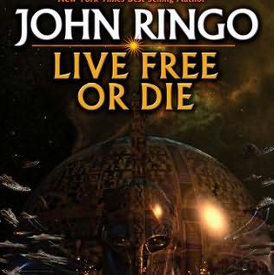
OBIR: Occasional Biased and Ignorant Reviews reflecting this reader’s opinion.

Into the Black: Tales of Lovecraftian Terror – by William Meikle
Self-published for Kindle in May, 2019 by William Meikle, Catalina, Newfoundland, Canada.
Cover art: Not listed.
Note: William Meikle is a Scottish author currently living in Canada.
Into the Black
Premise:
A British expedition drills deeper in an Antarctic ice basin than any previous expedition. A watery slush is brought up from beneath the ice, a slush that has not seen the sunlight for uncounted eons. Likewise the life within, including a microscopic black blob with a tendency to absorb any living thing it can engulf. Not something easily contained.
Review:
At first I took it for a Lovecraftian variation of the basis of John W. Campbell’s WHO GOES THERE, subsequently made famous in three movies about THE THING. Then, as matters progressed, it became a fresh take on Lovecraft’s own AT THE MOUNTAINS OF MADNESS. A fresh take? Yes, for it incorporates a symptom of Lovecraftian ecstasy not found, as far as I remember, in that particular tale but present in a number of others. As a result, the story is quite coherent and credible within itself, complete within its internal context, and thus the ending makes sense.
One of the attractions of a Lovecraft pastiche is the sense of the familiar. Lovecraft, of course, is famous for almost but not quite describing the indescribable in a precisely vague manner that evokes the exotic and eccentric imagery beloved by every devoted fan. Whereas Meikle writes in an easy, almost breezy style taking advantage of this imagery but limiting itself to hints rather than prolonged description. Some might say this is weak Lovecraft, not nearly as Lovecraftian as Lovecraft himself, but this is to miss the intent. I think Meikle’s style is quite deliberate, and offers a real advantage, for it lacks the ponderous tendency of much of Lovecraft’s writing, being more sprightly and fast-paced.
Consequently, the story comes across not only as a race toward the resolution, but a quick guided-tour of beloved tropes and themes where the reader’s pleasure is derived from recognizing various old friends as they pop up and pass on by. This accomplished while retaining the overall ambience of dread, frantic urgency, and dawning awareness of impending doom which are essential features in the Lovecraftian tales. This story is canon. It fits right in.
Broadsword
Premise:
Aliens appear before Prime Minister Winston Churchill demanding he stop the war or else. Two British agents are subsequently airdropped atop Trollenberg mountain in Austria to investigate.
Review:
The aliens are particular, rather nasty cosmic critters conceived by Lovecraft (I’ll let you read the story to find out which ones). The setting is in obvious homage to the 1958 British film THE TROLLENBERG TERROR (known in North America as THE CRAWLING EYE), but there is no similarity in plot other than perplexed humans clambering about a mountain peak worrying about an alien menace. I quite enjoyed this story. It is a successfull combination of Lovecraftian terror with a 1950s B-movie ambience that I find quite jolly and delightful. Mind you, I’m a sucker for this sort of thing. The fact that I can easily visualise it being made into a James Bond film shouldn’t deter you from reading it.
The Longdock Air
Premise:
The coal-slinging guitar player has had a song picking at the back of his mind for quite a while. Correspondence with fellow musician John Gilthrop convinces him old John is the answer to his problem. If he can just spend some time with old John he’ll learn all he needs to know about the song that has been haunting him., so he quits his job and drives to the port of Longdock to meet up with old John.
Review:
This tale is very much in the Innsmouth tradition, with a faint hint of THE MUSIC OF ERICH ZANN. Certainly the song is very much more than a mere song. Among other qualities it is the spell which attracts the protagonist to Longdock and ultimately defines his fate, which makes the story more coherent and complete than some Lovecraft pastiches I’ve read. One thing for sure, after reading this story I’m glad I never took up guitar picking.
The Color that Stole Christmas
Premise:
This time the alien meteor lands on a farm close to a small town preparing to celebrate Christmas.
Review:
Traditions are all very well, but sometimes they need to incorporate radical change to keep pace with new influences. Of course, traditionalists are always in an uproar, protesting even the slightest hint of “improvement,” but not everyone is so closeminded. The end of the world as we know it is certainly no reason to put off celebrating Christmas. Tis the season to be jolly, and Santa is particularly jolly this year. Sort of a Hallmark Christmas movie gone awry.
Outposts
Premise:
Flavius Butto has been summoned to a fort on the Antonine wall by his friend Marcus Caelius to solve a small problem; sentries keep dropping dead in the middle of the night, and not because of Pictish raiders. Something is frightening them to death.
Review:
I like Roman history, almost any fiction to do with Roman history, and crossing Roman history with Lovecraftian horror suits me just fine. I also like the fact the story takes place on the Antonine wall, further north than the more famous and longer-lasting Hadrian’s wall, and that the reason for this makes sense, the territory beyond the Antonine wall being wilder and more alien to Roman sensibilities than the partially settled region between the two walls. What lies beyond is a genuine mystery. Who knows what danger lurks? In this story we find out.
She Sleeps in the Depths
Premise:
Fallon keeps hearing a weird, hymn-like song in his sleep which is driving him to distraction. His boss suggests a vacation. He signs on for a voyage in a wee cruise ship to visit the Scottish isles. Onboard he meets a woman who dreams the same song.
Review:
Like most Lovecraftian fiction the plot is focused on an unfolding mystery. Unlike most Lovecraftian fiction the explanation revealed, and a nifty and original explanation it be, is the solution to the characters’ problem. Nice to see a concrete ending. Or is it? Time will tell.
The Call of the Deep
Premise:
The climate deniers were wrong. The seas have risen, the climate is unbearably hot, and millions of humanoid amphibians are laying siege to costal cities. Sam Green and John Ridder, two British army commandos, are sent to a U.S. airbase in northern England. The Americans are up to something.
Review:
The story cleverly takes the sort of simplistic one-solution-solves-all approach to climate change that erupts now and again when a scientist gets a bright idea without taking into account the fact the implications are unpredictable given our current lack of understanding in detail how Gaia actually functions and combines it with the likely response of all-powerful deities about which we know absolutely nothing (at least, that’s the premise). In short, will science solve the problem, or bugger things up irreversibly? We all know which the elder gods prefer, but surely human ingenuity will triumph? Hope not our only weapon? This story explores the possibilities.
On the Threshold
Premise:
John and Connon are two well-funded government scientists who’ve figured out how to create matter from nothing. Trouble is that’s not all they’ve created.
Review:
This story, originally published in 2013, employs a specific image which is the basis of the entire premise, an image which later appears in OUTPOSTS, published in 2017, in which the image serves as the facilitator of the plot and is but one element in a more complex situation. It would appear Meikle came up with a nifty visual and wrote a story about it, then later decided to use it again, only this time as a mere gimmick with the focus elsewhere. Nothing wrong with this. The original is a good, standard Lovecraftian vignette, but OUTPOSTS is a better story, methinks. Hardly matters. I like them both.
A True Telling of the Terror that Came to Redhook
Premise:
Inspector Malone believes the Dutchman Saydam is leading a bestial cult of child-sacrificing Kurdish devil-worshippers in Redhook, the worst slum in New York City, inhabited almost entirely by scarcely human immigrants from non-Aryan countries. Something like that is going on, but Malone’s suspicions are focused on the wrong people.
Review:
THE HORROR OF RED HOOK is perhaps Lovecraft’s most notorious short story, featuring numerous minorities criticized for their “horrible” Negroid or oriental features, singling out for particular abuse the “devil-worhipping” Yezidis (also known as Yazidiz), a Kurdish ethnic group with a unique pagan/Abrahamic religion persecuted throughout their history and most recently by Isis (at least 5,000 massacred, 7,000 taken into slavery, and many thousands driven from their communities). A long suffering people, by no means safe even now though the Isis threat has receded. Seems their neighbours have scant tolerance for their beliefs.
A TRUE TELLING OF THE TERROR THAT CAME TO REDHOOK is Meikle’s brilliant retelling of Lovecraft’s story. In my opinion it is the standout tale in this anthology. Every Lovecraft fan should read it.
Essentially, the story is retold from the point of view of the minorities themselves, particularly that of a black jazz musician, and a Kurdish immigrant named Botan. It is made absolutely clear that the non-white inhabitants are simply working hard not only to survive but to prosper, and certainly do not reject the American dream but are keen on embracing it as much as they can. It is the Dutchman Saydam who is madly attempting to evoke the atavistic horrors of an obscure cult brought by early white settlers, and Malone who is positively dotty with his fevered racist paranoia declaring non-whites automatically guilty of crimes so spectacular he can’t even imagine them, which is not surprising since they are innocent, the actual child kidnappings and sacrifices having been committed by Lovecraftian non-humans raised from the depths of the Earth by Saydam. It’s implied that if said critters were formerly human, they are but the degenerate mutations of the original white settlers. Thus the whole focus of the original story is neatly turned on its head.
I think this is the best Lovecraft pastiche I’ve ever read. And since he, very late in his short life, began to appreciate FDR’s reforms and moderate his own racist assumptions, I think, had he lived and progressed for a few more decades, he would have agreed with me had this retelling been written before he died (overlooking the nitpicky point his original story would not yet have been in public domain). Or perhaps I’m being very naive in assuming highly intelligent people (which Lovecraft certainly was) are capable of rejecting the perverse and evil ideologies they absorbed from their contemporaries when young.
At any rate I think Meikle’s revision is an excellent version of the original story, explaining what actually happened in a calm and rational manner while retaining all the “legitimate” techniques of Lovecraftian mood building while rejecting, indeed annihilating, the original racist slant. Reborn this way, RED HOOK becomes a wonderful horror story. I’m very, very impressed.
Vulcan’s Forge
Premise:
Septimus and Gavinius are Roman engineers who have found an entrance into a vast series of caverns within Mount Vesuvius. The wonders they discover convince General Flavius Meranus that a new war-winning weapon is at hand. He orders the pair to harness the power for the good of Rome. Septimus is not certain this is possible, or wise.
Review:
Again, Roman history combined with Lovecraftian horror. I love it. I’ll just say it throws a whole new light on the catastrophe at Pompeii and Herculaneum. Involves a mechanical device I’ve never come across before. Kudos to Meikle’s imagination.
The Wonderful Magician
Premise:
A man wants to capture the haunting music he first heard in his dreams when he was a child. At last technology has reached the point where he can not only play his dreams but convert them into a physicality. Unfortunately, he had not thought through the implications of what he is trying to do.
Review:
This is another variant, published in 2015, of a visual to do with evoking the unknown, dating at least as far back as 2013 in ON THE THRESHOLD. At worst, an author recycling material. At best, an author comfortable with variations on a theme appropriate to the plot. The story does work as a standalone. I’m just not convinced that putting three stories incorporating imagery in common in one anthology is a good idea. It raises the spectre of repetition. This threatens to lesson the impact of the individual stories. On the other hand, perhaps it reinforces the reassuring sense of the familiar so necessary to Lovecraft pastiches.
It could be I’m harping on a minor irritant that wouldn’t bother the majority of readers whatsoever. Which is another way of saying it’s no big deal. The story is okay. Just not one of my favourites.
The Last Quest
Premise:
King Arthur, or at least his 48th descendent of the same name and title, is sore pressed by frequent raids on Londinium by Saxon dirigibles. The descendants of the original Round Table Knights are a pathetic lot but thank goodness the original Merlin is still around, though he seems to be growing long in the tooth. Fortunately, all that is required to win victory with Excalibur is to make use the Holy Grail. Unfortunately, nobody has found it yet. Luckily, Merlin thinks he knows where it is.
Review:
Make that four stories with virtually identical imagery to do with conjuring up the universe beyond knowledge. Beginning to think of it as a Meikle trademark. Puts me in mind of Homer, instead of saying “sea” he almost always says “wine-dark sea.” It’s an old Bard’s trick, to have a stock of standard phrases and images to form a kind of backbone while filling in with original bits. It works in epic poetry and oral story-telling in general. Not so effective in an anthology. Repetitive enough to risk knocking the reader out of the story, at least temporarily.
In this case, however, combining Arthurian legend with Lovecraftian mythos, plus throwing in a steampunk twist, and some digs at the inadequacy of a hereditary ruling class, makes for an interesting and occasionally amusing tale.
CONCLUSION:
Overall, a good, readable collection of Lovecraft pastiches, some better than others, and one, A TRUE TELLING OF THE TERROR THAT CAME TO RED HOOK, absolutely outstanding. Even the least of the stories I enjoyed reading, most I really enjoyed, several left me feeling quite happy I’d read them, and one, as mentioned, completely blew me away. Not a bad record for any anthology.
Further, let me point out this isn’t just a self-published collection of stories. No hint of vanity press here. Every single one of these stories was previously accepted and published by a professional publication, collectively in many different publications. William Meikle be a professional working author. Not an amateur.
He’s published more than thirty novels and anthologies, only some in the style of Lovecraft, others in the traditions of William Hope Hodgson and Conan Doyle, plus a number of military/adventure works in his own voice.
His writing style belongs to the “Plain Glass” school. Though often precise and vivid, it doesn’t get in your way but allows you to see the story beyond and immerse yourself in the experience of witnessing it unfold. Very cinematic and pleasingly fast-paced. Makes it easy to sit back and enjoy the story.
In sum, a solid two thumbs up. Be sure to peruse the variety of offerings on his website. Bound to be something that will intrigue you. Quite a few intrigue me. A prolific and highly entertaining author.
Check it out at: < Into the Black >
Check out his website at < William Meikle >










